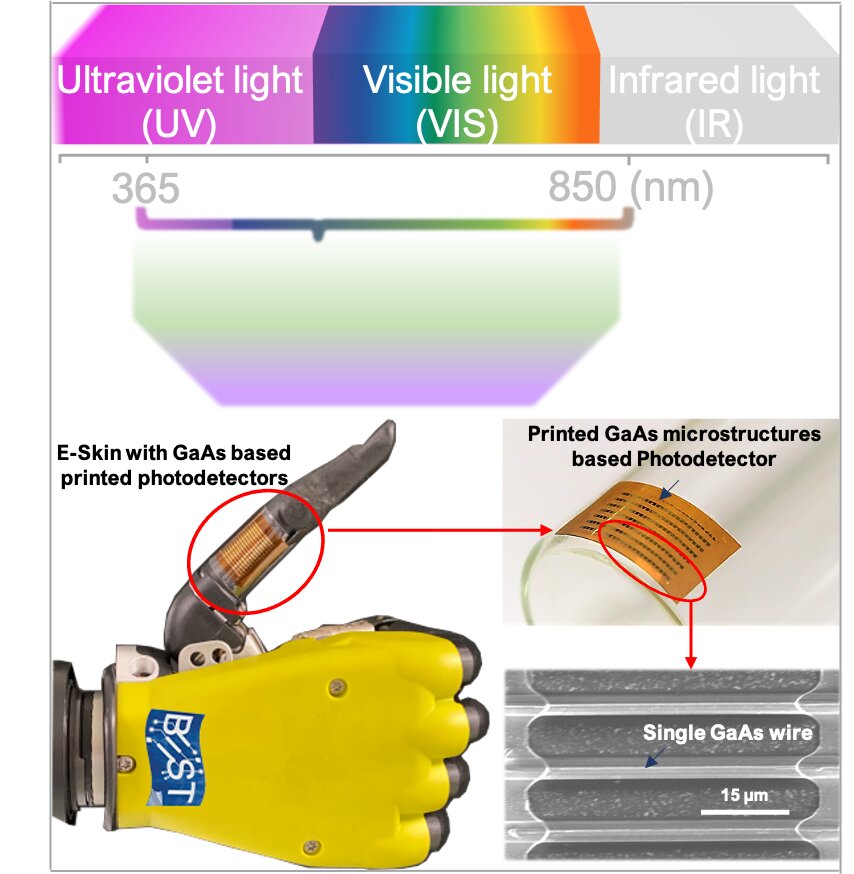Engineers at the University of Glasgow designed and developed a flexible, broadband photodetector that could be used in an electronic skin for robotics, as well as in other sectors. Such a photodetector-based skin could enable robots to perceive information by using detected light to effectively “see” beyond the range of human vision.
As an electronic skin, the team’s technology could enable robots to detect light from the UV, through the visible portion, and to the IR.
According to Ravinder Dahiya, head of the Bendable Electronics and Sensing Technologies research group in University of Glasgow’s James Watt School of Engineering, the electronic hardware used in robotics is not always designed for harsh conditions, such as in a radiation environment. The skin — with additional features — could detect light in these harsh conditions to benefit robots “wearing” the skin, he said.
“In specialized environments such as cleanrooms in electronic manufacturing and the pharmaceutical sector, different spectra of light are needed for the treatment of different materials,” Dahiya said. “Since robots are used in such environments, the e-skin, with the capability to detect light in different spectra, could enable a robot’s reliable operation.”
The technology supports additional systems and applications, including wearable systems. “For example, wearables could detect the exposure of skin to UV light and trigger action when levels rise above a safe limit,” Dahiya said. “One could also see the use of robots with these capabilities in areas such as skin disease treatment.”
The feedback from photodetectors could also support autonomous mobility, particularly in instances in which a robot might move from an environment in which one wavelength of light is present to an environment in which another is present. The team did not perform tests to demonstrate this functionality in the current work.

A flexible photodetector developed by a team at the University of Glasgow is poised to provide future robots with an electronic skin capable of 'seeing' light beyond the range of human vision. The development supports the ability of robots to perform in harsh environments, such as cleanrooms in the pharmaceutical and materials science sectors. Courtesy of the University of Glasgow.
Tests showed that the photodetector system obtained an ultrafast response to light, taking 2.5 ms to measure light and 8 ms to recover. The researchers said that this rate of performance is comparable to the best conventional photodetectors currently available on the market.
Dahiya added that the photodetector technology described in the current work involves a physically flexible detector — a feature that distinguishes it from conventional offerings, although GaAs-based broadband photodetectors have been developed.
The team’s development involves a newly developed method for printing microscale semiconductors made from gallium arsenide (GaAs) onto a flexible plastic surface. Though GaAs is widely used to create high-performance electronics, these electronics have been mainly created on rigid surfaces.
The Glasgow team believes it is among the first to find a way to use GaAs on a flexible substrate. In the current research, it adapted its existing roll printing system for GaAs electronics onto a flexible surface using arrays of wires that are 15 μm in width. The team subjected the material to tests in a machine designed to bend and twist it hundreds of times. Over the course of 500 cycles, the material demonstrated no significant loss in performance.
Like silicon, GaAs is brittle and cannot be grown directly on flexible substrates, Dahiya said. Use of the direct roll printing method showed the versatility of the approach used by the team.
He said the team hopes to extend its work to show how the photodetector based e-skin could be used in robotics in real world settings and applications.
“Mechanical arms used for manufacturing in light-sensitive environments, for example, could become capable of detecting when conditions change and the safety or effectiveness of their work is put at risk,” Dahiya said. “Flexible, broad-spectrum photodetectors could also find use in a wide range of wireless communication technologies, where the fast transmission and response speeds we’ve tested are always in demand."
The research was published in Advanced Materials Technologies (www.doi.org/10.1002/admt.202200772).